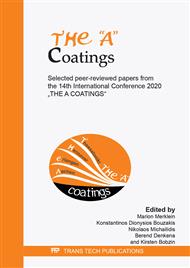[1]
LE. Murr, Metallurgical effects of shock and high-strain-rate loading, Blazynski TZ, editor, Materials at high strain rates, Essex (England), Elsevier, 1987, p.1–46.
Google Scholar
[2]
J. Harding, The effect of high strain rates on material properties, Blazynski TZ, editor, Materials at high strain rates, Essex (England): Elsevier, 1987, p.133–86.
Google Scholar
[3]
BL. Boyce, MF. Dilmore, The dynamic tensile behavior of tough, ultra-high strength steels at strain-rates from 0.0002 s-1 to 200 s-1. Int. J Imp. Eng., 36(2): 2009, p.263–71.
DOI: 10.1016/j.ijimpeng.2007.11.006
Google Scholar
[4]
L. W. Meyer, Material behaviour at high strain rates, 1st International Conference on High Speed Forming,.
Google Scholar
[5]
K.-D. Bouzakis, G. Maliaris, S. Makrimallakis, Strain rate effect on the fatigue failure of thin PVD coatings: An investigation by a novel impact tester with adjustable repetitive force, International Journal of Fatigue, 44, 2012, pp.89-97.
DOI: 10.1016/j.ijfatigue.2012.05.010
Google Scholar
[6]
K.-D. Bouzakis, M.-G. Gökcen, A-U. Batuk, S. Sisman, G. Skordaris, A. Boumpakis, T. Kotsanis, A. Bouzakis, Stress, strain, strain-rate cemented carbide data defined via a FEM-supported evaluation of impact test imprints, 10th International Congress on Machining, Antalya Turkey, 2019, pp.214-220.
DOI: 10.1016/j.ijrmhm.2020.105384
Google Scholar
[7]
K.-D. Bouzakis, N. Michailidis, G. Erkens, Thin hard coatings stress strain curve determination through a FEM supported evaluation of nanoindentation test results, Surface and Coatings Technology 142-144, 2001, pp.102-109.
DOI: 10.1016/s0257-8972(01)01275-0
Google Scholar
[8]
K.-D. Bouzakis, N. Michailidis, Hadjiyiannis S, Skordaris G, Erkens G., The effect of specimen roughness and indenter tip geometry on the determination accuracy of thin hard coatings stress–strain laws by nanoindentation. Mater. Charact., 49(2), 2002, p.149–56.
DOI: 10.1016/s1044-5803(02)00361-3
Google Scholar
[9]
K.-D. Bouzakis, N. Michailidis, Deviations in determining coatings' and other materials' mechanical properties, when considering different indenter tip geometries and calibration procedures. Surface & Coatings Technology, 202, 2007, p.1108–1112.
DOI: 10.1016/j.surfcoat.2007.07.042
Google Scholar


